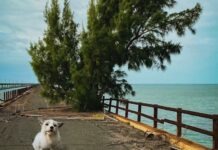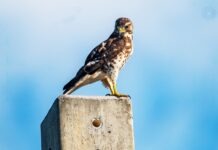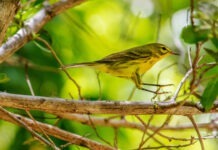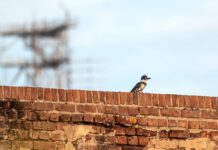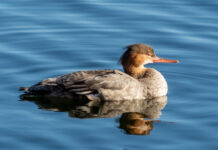A northern waterthrush is the color of root beer. It’s the color of the Danish modern couch my parents brought back from Germany when they lived there, the one we had before the velvety blue one, the one that was always too itchy to nap on. It’s the color of the stain-proof polyester uniform my friend Laurie wore when she worked at the Lucky 7 Dairy Bar in Medford, New Jersey in 1985, before the place burned to the ground, was rebuilt, then burned to the ground again. It’s the color of the 1973 Dodge Duster my sister had. It’s a color now seldom seen in the manmade world.
Really, though, a northern waterthrush, at least the parts that aren’t yellowy white-ish, is the color of mud. Which works for them.
I bring this up because I saw my first one of the season the other day. And my second one. And my fourth one. They’ll be around for the next six or seven months, but it’s still a challenge to get a good look at them.
The northern waterthrush is a wood warbler, one of the vast mixed bouquet of 40 species of wood warblers recorded in the Keys. They’re migrants, though arguably some of them spend more time here than in their breeding territory. They are tied with the Louisiana waterthrush for third-drabbest warbler. Its Louisiana counterpart looks so much like a northern waterthrush that birders sometimes argue about which one they see, a debate that can prompt years-long grudges. (The award for drabbest and second-drabbest warbler goes to the Swainson’s warbler and the orange-crowned warbler, but that’s another story.)
The drab color serves a purpose. It always brings to mind those John le Carré characters whose ability to fade unnoticed into the background make them the effective spies. (Kind of the opposite of the James Bond/Archer model.) The plain brown wrapper is not so much camouflage as a disenchantment spell, aimed not so much at espionage – who are they going to tell their secrets to? – but rather moving through the world without drawing attention.
There are generally two ways to find a northern waterthrush – by sound or by the fact that they are creatures of habitat.
Most bird books, especially the older ones, go on and on about the melodious beauty of their song. And it is, in fact, a lovely song if you listen to the recordings. But it’s not something we hear here, as they are not trying to stake out breeding territory or attract a mate. What we get is their chip, the one-note contact call that warblers make to let other warblers know where they are. The northern waterthrush’s contact call is distinct – lower in pitch than most warblers, sounding a little slurred, almost like the bird is trying to issue two identical notes at the same time. Once you hear it, it is only a matter of patience until you catch sight of one.
The habitat they like is usually consistent – someplace wet with a lot of exposed earth/mud and a good bit of cover. They don’t really enjoy oceans or rivers, instead preferring swamps, salt ponds, seasonal wetlands and puddles. The stiller the water, the better. If it looks like a good spot to breed mosquitoes, it’s perfect, though the list of things they’ll pluck out of the mud – small crabs, mollusks, spiders, ants, flies, small seeds, grit and beetles – oddly does not include mosquitos.
The name waterthrush is a holdover from when they were misplaced on the taxonomic tree and thought to be very small thrushes that were fond of water. Once they were recognized as part of the wood warbler family, the name “bogbird” was suggested as more appropriate, but the folks at the American Ornithologists Union, who make the official bird-naming decisions, stuck with the shopworn and familiar name over an accurate and unconfusing one.
Northern waterthrushes are part of a personal and decidedly non-scientific classification I call “the rockers.” Not in terms of Springsteen, Heart, Car Seat Headrest or Van Halen, but because their body always rocks as they walk.
Palm warblers, with their always twitching tails, are in that category. As are spotted sandpipers.
Northern waterthrushes rock with a constant pelvic thrusting. I spent a lot of time looking at YouTube videos the other day before deciding it looks less like Elvis Presley’s 1956 appearance on the Milton Berle show and more like quarter-speed twerking, a slow boop boop boop of the hips. (Sometimes I look at them and imagine them bouncing a cartoon basketball with their rump.)
So while their earthy tones and tendency to lurk beneath logs and behind branches makes them hard to see, the rocking kind of blows their cover.
The purpose of all this rocking? Unknown. Anything you read about a northern waterthrush will describe the action, but no one with any scientific reputation seems to want to plumb the behavior.
There are theories: It matches the rhythm of ripples in the water, and thus helps hide them from predators. It helps disguise their approach to unsuspecting bugs, making it easier to sneak up on them. It helps scare unsuspecting bugs as they approach, creating panic and making them easier to spot. It shows predators they have a lot of excess energy, making them seem like a pain in the ass to catch. It shows their fitness to a mate. It helps them digest their food.
But really, no one knows. And thinking about science and the scientific method and the questions they are prepared to answer, there’s a good chance no one is ever going to really know. You just have to accept the fact that northern waterthrushes evolved this behavior over thousands of years, and for some reason, it works for them.
All you can really do is try to appreciate it as one of life’s odder mysteries and maybe, whenever you see one, think: keep on rocking, little dude. Keep on rocking.














